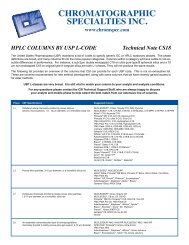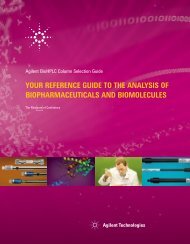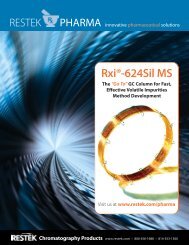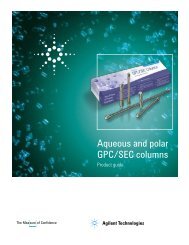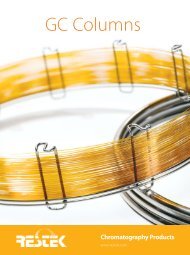Optimizing the Analysis of Volatile Organic Compounds
Optimizing the Analysis of Volatile Organic Compounds
Optimizing the Analysis of Volatile Organic Compounds
Create successful ePaper yourself
Turn your PDF publications into a flip-book with our unique Google optimized e-Paper software.
26<br />
www.restekcorp.com<br />
FID Maintenance and Troubleshooting: Contamination and a clogged jet are common<br />
problems associated with using an FID in analyses <strong>of</strong> volatile compounds, such as gasoline<br />
range organics (GRO) analyses that involve samples containing diesel fuel or oils. Flameouts<br />
at <strong>the</strong> beginning <strong>of</strong> a VOCs analysis usually are <strong>the</strong> combined result <strong>of</strong> incorrect gas<br />
flows and excessive water from <strong>the</strong> purge trap. When performing maintenance on an FID<br />
always check <strong>the</strong> gas flows before calibrating <strong>the</strong> instrument. Water management is discussed<br />
on page 13.<br />
ELCD (Hall ® detector) Operation<br />
In typical applications, an electrolytic conductivity detector, ELCD (Figure 21), is a chemical<br />
detector that catalytically reduces halogenated materials to haloacids, HCl and HBr, by<br />
mixing <strong>the</strong>m with high-temperature hydrogen in a heated nickel reaction tube. In o<strong>the</strong>r<br />
words, this detector pyrolyzes <strong>the</strong>se analytes in <strong>the</strong> presence <strong>of</strong> a catalyst and a reaction gas<br />
(hydrogen):<br />
H2 + CH3(CH2)nCH2R (heat and catalyst) –> CH3(CH2)nCH3 + RH<br />
where R=halogen (Br or Cl)<br />
Example:<br />
H2 + CH3Cl –> CH4+HCl<br />
The haloacid molecules flow into <strong>the</strong> electrolytic conductivity cell via a PTFE transfer line,<br />
and are dissolved in a stream <strong>of</strong> n-propanol. The conductivity <strong>of</strong> <strong>the</strong> alcohol is monitored<br />
because <strong>the</strong> concentration <strong>of</strong> hydrogen halide is directly proportional to <strong>the</strong> current. The signals<br />
thus produced characteristically have tailing peaks. Although <strong>the</strong> ELCD is most commonly<br />
used for halogenated compounds and, in <strong>the</strong> halogen mode, it is selective only for<br />
<strong>the</strong>se species (Figure 21), it can be configured to detect sulfur, nitrogen, and nitrosamine<br />
compounds. Figures 22-25 and Figure 27 show various important parts <strong>of</strong> <strong>the</strong> ELCD system.<br />
Figure 21.<br />
ELCD configured for detecting halogens.<br />
TFE Transfer Line<br />
Reactor<br />
Reaction Tube<br />
Reaction Gas<br />
Vent<br />
Solvent<br />
Exit<br />
Silicone<br />
“O” Ring<br />
PTFE<br />
Seal<br />
Signal Out<br />
Cell Excitation<br />
Voltage<br />
Solvent In<br />
Conductivity<br />
Cell<br />
Outer<br />
Electrode<br />
Inner<br />
Electrode<br />
Tube Nut<br />
Gas Effluent from Reactor<br />
Outer Electrode<br />
Cell Body<br />
Insulator<br />
Inner Electrode<br />
Cell Cap<br />
Wave Spring<br />
Courtesy <strong>of</strong> Thermo Finnigan





